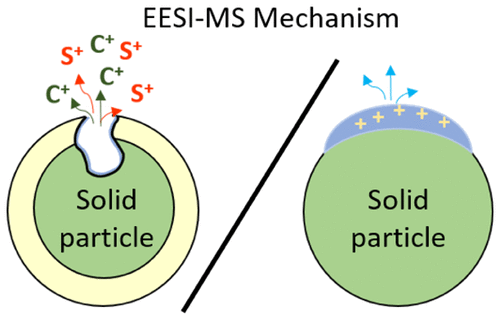当前位置:
X-MOL 学术
›
Anal. Chem.
›
论文详情
Our official English website, www.x-mol.net, welcomes your feedback! (Note: you will need to create a separate account there.)
New Mechanism of Extractive Electrospray Ionization Mass Spectrometry for Heterogeneous Solid Particles
Analytical Chemistry ( IF 6.7 ) Pub Date : 2018-01-11 00:00:00 , DOI: 10.1021/acs.analchem.7b04164 S. Kumbhani 1 , T. Longin 2 , L. M. Wingen 1 , C. Kidd 1 , V. Perraud 1 , B. J. Finlayson-Pitts 1
Analytical Chemistry ( IF 6.7 ) Pub Date : 2018-01-11 00:00:00 , DOI: 10.1021/acs.analchem.7b04164 S. Kumbhani 1 , T. Longin 2 , L. M. Wingen 1 , C. Kidd 1 , V. Perraud 1 , B. J. Finlayson-Pitts 1
Affiliation

|
Real-time in situ mass spectrometry analysis of airborne particles is important in several applications, including exposure studies in ambient air, industrial settings, and assessing impacts on visibility and climate. However, obtaining molecular and 3D structural information is more challenging, especially for heterogeneous solid or semisolid particles. We report a study of extractive electrospray ionization mass spectrometry (EESI-MS) for the analysis of solid particles with an organic coating. The goal is to elucidate how much of the overall particle content is sampled, and determine the sensitivity of this technique to the surface layers. It is shown that, for NaNO3 particles coated with glutaric acid (GA), very little of the solid NaNO3 core is sampled compared to the GA coating, whereas for GA particles coated with malonic acid (MA), significant signals from both the MA coating and the GA core are observed. However, conventional ESI-MS of the same samples collected on a Teflon filter (and then extracted) detects much more core material compared to EESI-MS in both cases. These results show that, for the experimental conditions used here, EESI-MS does not sample the entire particle but, instead, is more sensitive to surface layers. Separate experiments on single-component particles of NaNO3, GA, or citric acid show that there must be a kinetics limitation to dissolution that is important in determining EESI-MS sensitivity. We propose a new mechanism of EESI solvent droplet interaction with solid particles that is consistent with the experimental observations. In conjunction with previous EESI-MS studies of organic particles, these results suggest that EESI does not necessarily sample the entire particle when solid, and that not only solubility but also surface energies and the kinetics of dissolution play an important role.
中文翻译:

异质固体颗粒萃取电喷雾电离质谱的新机理
空气中颗粒的实时原位质谱分析在多种应用中都很重要,包括环境空气中的暴露研究,工业环境以及评估对能见度和气候的影响。但是,获得分子和3D结构信息更具挑战性,尤其是对于异质固体或半固体颗粒而言。我们报告了萃取电喷雾电离质谱(EESI-MS)的研究,以分析带有有机涂层的固体颗粒。目的是阐明要采样的总颗粒含量是多少,并确定该技术对表面层的敏感性。结果表明,对于涂有戊二酸(GA)的NaNO 3颗粒,几乎没有固体NaNO 3与GA涂层相比,样品的磁芯被采样,而对于涂有丙二酸(MA)的GA颗粒,则观察到来自MA涂层和GA芯的重要信号。但是,在两种情况下,与使用EESI-MS相比,在特富龙过滤器上收集(然后提取)的相同样品的常规ESI-MS检测到的芯材要多得多。这些结果表明,对于此处使用的实验条件,EESI-MS不会对整个粒子进行采样,而是对表面层更敏感。NaNO 3单组分颗粒的单独实验,GA或柠檬酸表明对溶解必须有动力学限制,这对确定EESI-MS灵敏度很重要。我们提出了一种新的EESI溶剂滴与固体颗粒相互作用的机制,该机制与实验观察结果一致。结合先前对有机颗粒的EESI-MS研究,这些结果表明,当固体时EESI不一定对整个颗粒进行采样,不仅溶解度而且表面能和溶解动力学都起着重要作用。
更新日期:2018-01-11
中文翻译:

异质固体颗粒萃取电喷雾电离质谱的新机理
空气中颗粒的实时原位质谱分析在多种应用中都很重要,包括环境空气中的暴露研究,工业环境以及评估对能见度和气候的影响。但是,获得分子和3D结构信息更具挑战性,尤其是对于异质固体或半固体颗粒而言。我们报告了萃取电喷雾电离质谱(EESI-MS)的研究,以分析带有有机涂层的固体颗粒。目的是阐明要采样的总颗粒含量是多少,并确定该技术对表面层的敏感性。结果表明,对于涂有戊二酸(GA)的NaNO 3颗粒,几乎没有固体NaNO 3与GA涂层相比,样品的磁芯被采样,而对于涂有丙二酸(MA)的GA颗粒,则观察到来自MA涂层和GA芯的重要信号。但是,在两种情况下,与使用EESI-MS相比,在特富龙过滤器上收集(然后提取)的相同样品的常规ESI-MS检测到的芯材要多得多。这些结果表明,对于此处使用的实验条件,EESI-MS不会对整个粒子进行采样,而是对表面层更敏感。NaNO 3单组分颗粒的单独实验,GA或柠檬酸表明对溶解必须有动力学限制,这对确定EESI-MS灵敏度很重要。我们提出了一种新的EESI溶剂滴与固体颗粒相互作用的机制,该机制与实验观察结果一致。结合先前对有机颗粒的EESI-MS研究,这些结果表明,当固体时EESI不一定对整个颗粒进行采样,不仅溶解度而且表面能和溶解动力学都起着重要作用。







































 京公网安备 11010802027423号
京公网安备 11010802027423号